While many people think that eels are slimy, elongated, ugly creatures that live underwater, but they actually look quite beautiful and interesting. The truth is that some fish species can be mistaken for an eel because of their long body shape and snake-like movements.
However, what fish look like an eel? The fish species that has similarities with eels but not a true eel are – Bichir/ Polypterus senegalus/ Polypterus palmas, Reedfish, Aenigmachanna Gollum, Pangio (Kuhli), Cutlassfish, West African lungfish, Rock gunnel, Eel-tailed catfish, and some popular eel species are Electric Eel, Asian Swamp Eel, Fire Eel, Moray eel, and Dragon eel, etc.
Here are some similar articles we’ve covered on our site. If you feel interested, click the links below to read them.
14 Most Common Fishes That Looks Like a Snake.
12 Fishes with Dragon-like Appearances.
Now, let’s get to our today’s blog topic-
Fishes That Look Similar to an Eel
1. Bichir/Polypterus senegalus
Bichir is the air-breathing tropical fish from the genus Polypterus. This freshwater habitant is native to the Nile river system and Africa. And the primary location is the shallow floodplains, swamps, and estuaries in those areas.
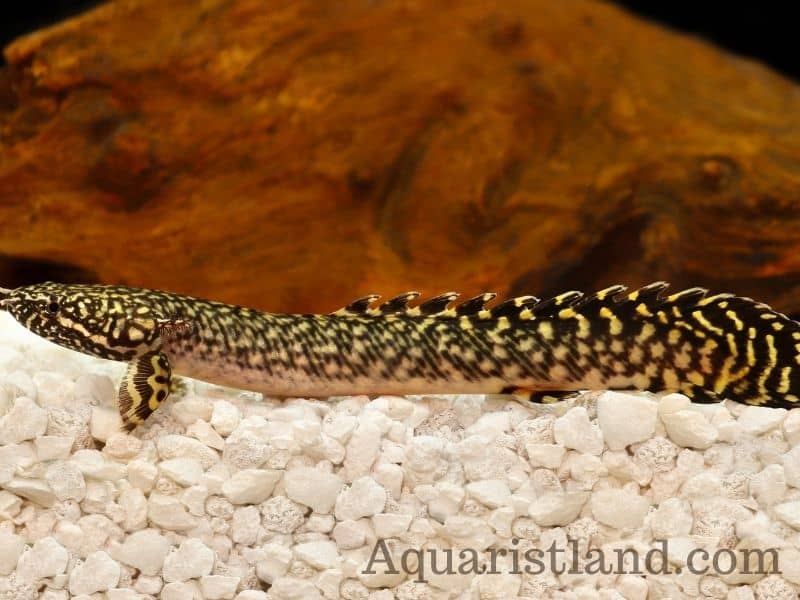
Characteristics:
- Bichir is the family of archaic-looking ray-finned fish.
- Polypterids are elongated fish with a unique series of dorsal finlets.
- The body is covered in thick, bonelike, and rhombic (ganoid) scales.
- Jaw structure closely resembles tetrapod.
- The fleshy pectoral fins are similar to the lobe-finned fishes.
- They also have a pair of slit-like spiracles on the head to breathe air.
- Depending on the species and morphology, Bichir will reach around 100 cm in length.
- They’re nocturnal and feed on small vertebrates, crustaceans, and insects.
Bichir In Aquarium:
- They’re semi-aggressive, and the care level is intermediate.
- Common Aquarium Diet includes Bloodworms.
- Polypterids in captivity have life expectancies up to 10-15 years.
- Minimum Tank Size: 90 Gallons or more.
- In captivity, they will live around 15-20 years by growing about 10-30 inches in length.
Similarities with Eels:
Both eels and Bichir are ray-finned fish species. Moreover, the elongated body of these two species is identical to each other. The shape of Bichir is also similar to the eels, and they both prefer shallow water areas. Besides those, their jaw structure is partially alike.
Differences with Eels:
The skin of eels is slippery, while the Bichir has thick, bonelike, and rhombic scales. Also, the Bichir has a unique series of finlets that are absent on the eels. Moreover, Bichir is mainly a freshwater habitant, while the eels are from both fresh and saltwater.
2. Reedfish/Ropefish
The ropefish, reedfish, or snakefish are a part of the bichir order and family. They are freshwater species from central and West Africa. Reedfish use pectoral fins to make an eel-like form of swimming to create faster movements.
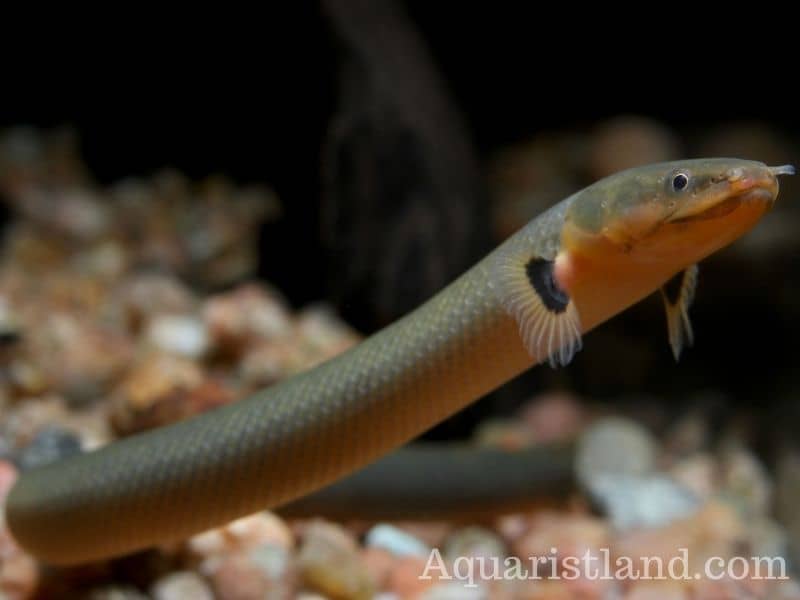
Characteristics:
- Ropefish has Greenish-brown color with yellowfins.
- It has an eel-like, elongated body without a trace of a ventral fin.
- The long dorsal fin of reedfish consists of a series of well-separated spines, each supporting one or several articulated membranes and rays.
- The reedfish possesses a pair of lungs that help them to breathe atmospheric air. So, they can survive in very oxygen-poor water.
- It can reach a maximum length of 37 cm (15 in).
- The reedfish inhabits slow-moving or standing brackish or fresh warm water at 22–28 °C (72–82 °F).
Reedfish in Aquarium:
- It’s a large peaceful fish, and taking care is comparatively easy.
- Recommended Tank size is around 40-45 gallons.
- In captivity, they will survive around 15 years with a length of about 15 inches.
- Meaty frozen foods are the best choice for them in the aquarium.
Similarities with Eels:
The ropefish’s long elongated body with slippery skin is similar to eels. When they try to swim faster, they make an eel-like swimming form. Both of them have a body that looks like a snake and can make you confused easily.
Differences with Eels:
Except for the look and movement, there are very few identical similarities present between eels and ropefish. Moreover, reedfish is a smaller species compare to a giant eel with a 4 m length.
3. Aenigmachanna Gollum:
Another fish species from the ray-finned genus, and the order is Ananbantiformes. In the family of Ananbantiformes or dragon snakeheads, it’s the only group containing two subspecies. And their habitats in southwestern India; especially, in the state of Kerala.
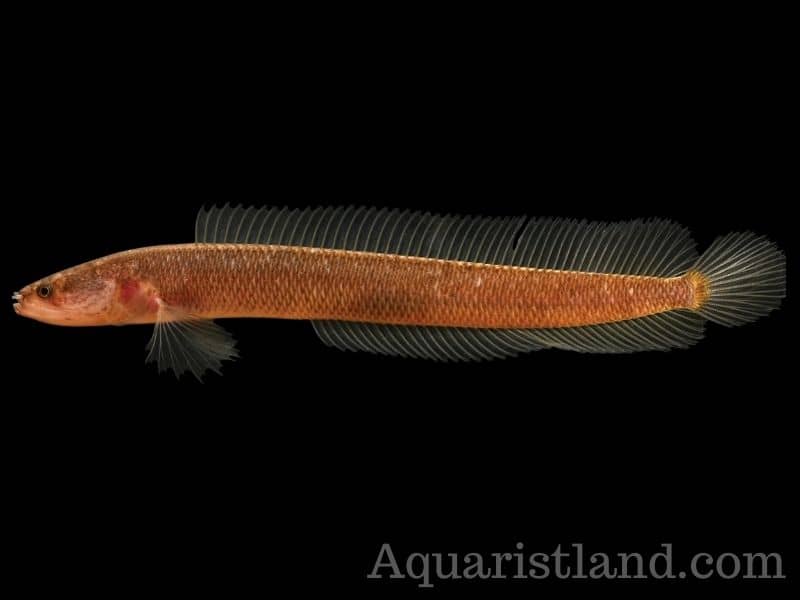
Characteristics:
- A. Gollum has an elongated, eel-like body.
- The body color is mostly brown and beige.
- It fins are long and transparent
- Its pectoral fin is large, while the pelvic fin is absent.
- Like other snakehead fishes, it breathes air
- It moves by undulating its fins like an eel.
- A. Gollum is named after the cave-dwelling character Gollum from J. R. R. Tolkien’s The Hobbit and The Lord of the Rings book series.
Aenigmachanna Gollum in Aquarium:
There is no valid reference or record about keeping A. Gollum in the aquarium.
Similarities with Eels:
Aenigmachanna Gollum is a ray-finned species like the eels. The long slender body is just eel-like. While moving into the water, A. Gollum undulated its fins like most eel species. Moreover, both of them don’t have any pelvic fins.
Differences to Eels:
Aenigmachanna Gollum has a large pectoral fin, while the eels have very small or don’t have at all. It’s a small fish with about four inches of length compared to giant eels. And A. Gollum is an aquifer-dwelling fish.
4. Cutlassfish (Largehead hairtail):
The Largehead hairtail is also known as beltfish. It’s a predatory fish from the family of Cutlussfish. These species are abundant in tropical ocean areas. And are common in the Atlantic, East Pacific, and North Pacific.

Characteristics:
- Largehead hairtails are silvery steel blue in color.
- This fish is elongated in shape with a thin pointed tail.
- The eyes are large, and the largemouth contains long, pointed fang-like teeth.
- They have reduced or absent pelvic and caudal fins giving them an eel-like appearance.
- The tail is greatly reduced in size.
- It can grow around 150 cm or more.
Cutlassfish (Largehead hairtail) in Aquarium:
There are no valid references for having this fish in an aquarium.
Similarities with Eels:
The extended body shape of the Largehead hairtail is similar to the eels. Another similarity is the absence of the pelvic fins, and caudal fins are highly similar to eels.
Differences with Eels:
Cutlassfish (Largehead hairtail) are found only in the saltwater territory. And the jaw structure between eels and cutlassfish varies. The maximum length is also are different from each other.
5. West African lungfish:
The West African lungfish has another name Tana lungfish. It’s widely found in freshwater territories of the middle, west, and some parts of southern Africa. They burrow deeply into the mud when their water supply decreases.
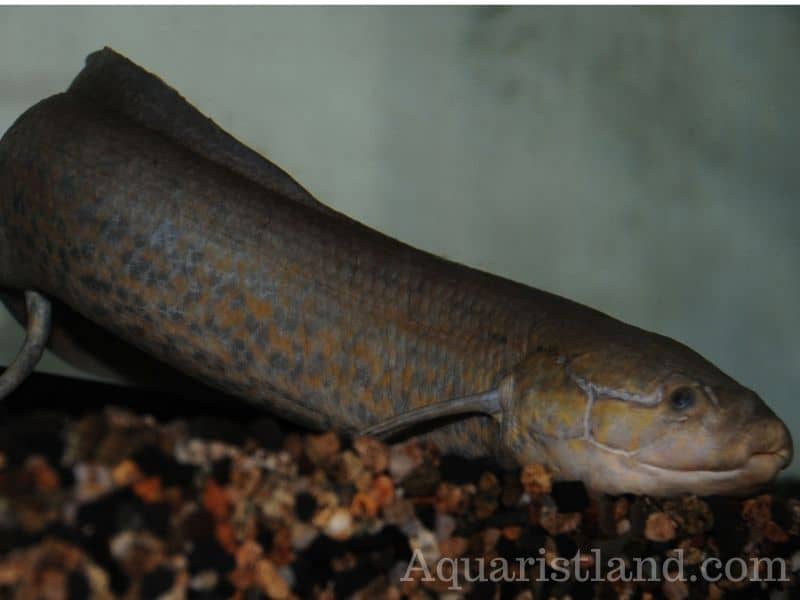
Characteristics:
- The African Lungfish has a prominent snout and small eyes.
- The body is long and eel-like.
- It has two pairs of long, filamentous fins.
- The pelvic and pectoral fins are larger than the head size.
- Lungfish have cycloid scales embedded in the skin.
- It’s an olive color fish with brownish spots on fins and body.
- They reach a length of about 1 m (3.3 ft) in nature.
West African Lungfish in Aquarium:
- It’s moderately big semi-aggressive fish.
- Recommended Tank size is 60 gallons or more.
- In captivity, the African lungfish can grow about 50-60 Inches.
- They can live around 20 years in Aquarium.
- Taking care is moderately easy.
- This fish is a carnivore and eats almost any protein-rich food.
Similarities with Eels:
The long body shape is highly alike to an eel. The look is the main similarity between them. And both species are freshwater habitants. However, some species of eels are from saltwater.
Differences with Eels:
The biggest difference is the pelvic and pectoral fins on the African lungfish compare to eels. The scales on the lungfish are cycloid, while the scale on the eels’ body is oval-shaped.
6. Pangio (Loach/Kuhli):
The Pangio is a small freshwater species from the family Cobitidae in the true loach. They are well known among aquarium hobbyists and are native to Asia (mainly in Southeast Asia). Pangio inhabits the streams, backwaters, and swamps. There’re 33 species of this kind, and Kuhli Loach is one of them.
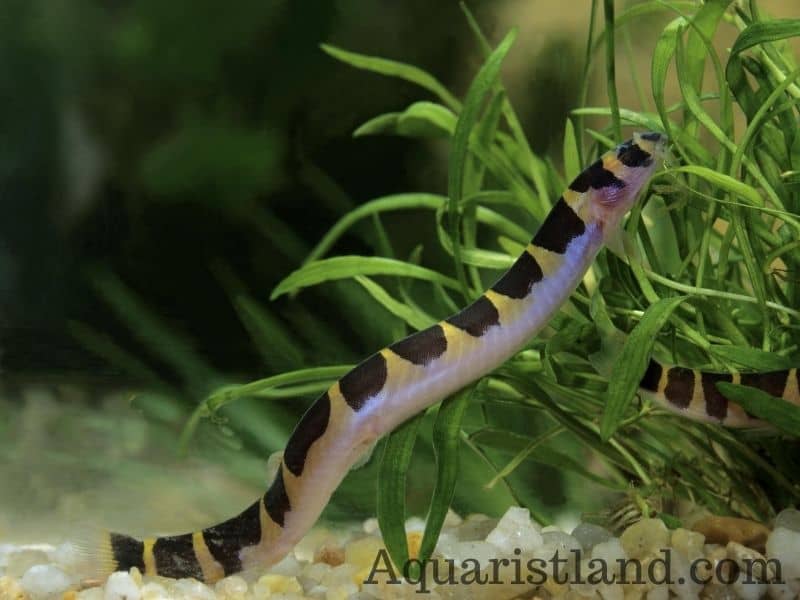
Characteristics:
- The Body is very slender.
- It’s an eel-shaped fish with slightly compressed sides.
- It has very small fins and four pairs of barbels.
- Pangio has dorsal and anal fins like an eel.
- The body has 10 to 15 dark brown to black vertical bars, making them look like a snake.
- The maximum length is around 4 inches or 10 cm.
Pangio in Aquarium:
- Peaceful freshwater fish
- Care level is Intermediate.
- In captivity, they live around 10 years.
- They’re omnivore fish and prefer live food.
- They’ll reach around 4 inches in length.
- Not a schooling fish, but enjoy company.
Similarities with Eels:
The slender body of Pangio is eel-like shaped. Both Pangio and eels have dorsal and anal fins. Moreover, the snake-like body and movement are very similar between them.
Differences with Eels:
Pangio is a very small species compare to an eel. It has 10-15 dark brown vertical bars on its body, which is absent on eels. And the Pangio has four pairs of barbels.
7. Rock gunnel (Pholis gunnellus):
The rock gunner is ray-finned species also known as butterfish and is one of the two species of the gunnel. It’s an eel-like fish that inhabits the Atlantic Oceans. It prefers the shallow parts of the ocean. Rock gunnel’s flat and elongated body shape will confuse you for an eel.
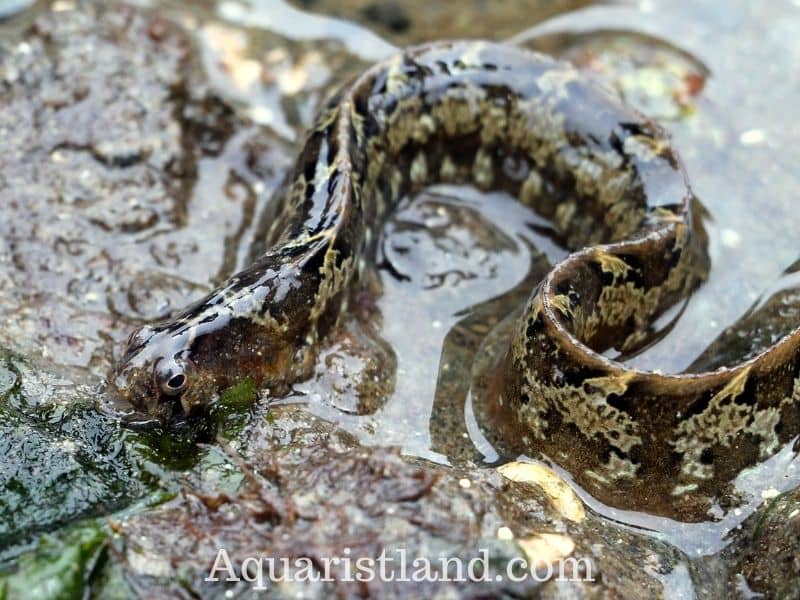
Characteristics:
- The body is elongated and flat.
- Naturally brown colored with yellowish markings creating a regular pattern.
- A full-grown Rock gunnel will be about 30 cm long.
- It has dorsal, anal, caudal, and pelvic fins.
- The skin is slimy.
- The head is comparatively small.
- And the jut outed lower jaw makes the mouth upward.
Rock Gunnel in Aquarium:
- It’s a hardy Coldwater/Saltwater fish.
- Taking Care is Easy.
- Tank size is moderate.
- In captivity, the highest length will be around 25 cm.
- The diet consists of crustaceans, polychaetes, and mollusks. However, in the aquarium, try feeding live foods.
Similarities with Eels:
Even though the Rock gunnel is a small fish compared to an eel, the body shape and structure are highly similar. Both of them are ray-finned species with long and flat body shapes. Moreover, the dorsal and anal fins are similar between rock gunnel and eel. Besides, they both have slimy skin.
Differences with Eels:
With the highest length of 30 cm, Rock gunnel is a very small fish species compared to an eel. The pelvic fins on rock gunnels are small that are absent on the eels. Moreover, the rock gunnel inhabits only saltwater.
8. Eel-tailed catfish (Tandanus Catfish)
The eel-tailed catfish is a freshwater catfish species known as tandan, dewfish, jewfish, and freshwater catfish. They usually live in the slow-moving Murray-Darling river system of Eastern Australia. Eel-tailed catfish is an interesting pond or aquarium subject that can withstand various water conditions.
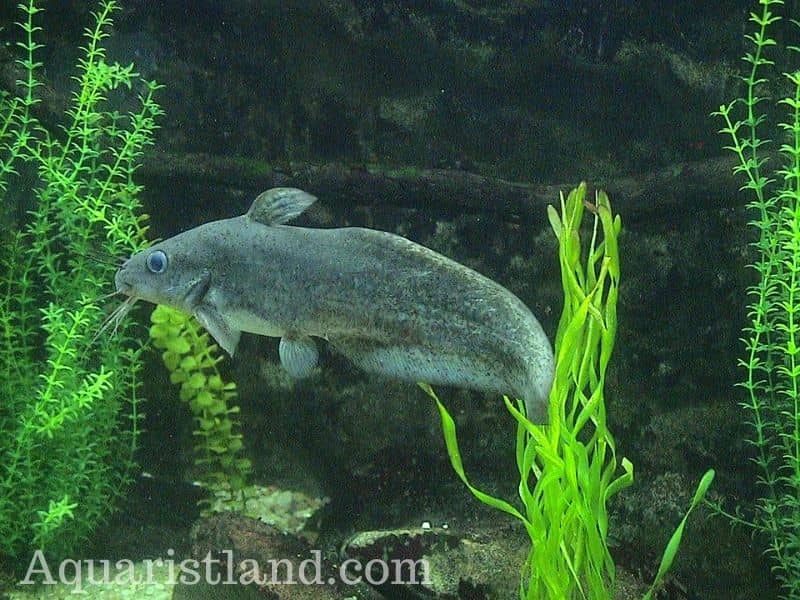
Characteristics:
- It has a large head with thick and fleshy lips and tubular nostrils.
- The skin is tough and smooth
- Body color varies from brown to olive-green with a white underside and purplish or black on its backs.
- They are a solid, almost cylindrical, elongate fish, with the posterior half of their body tapering into a pointed eel-like tail.
- Sharp serrated dorsal- and pectoral-fin spines are venomous and can cause a painful injury.
- Eel tailed can grow about 50 cm in length with a weight of 1.8 KG.
Eel-Tailed Catfish in Aquarium:
- Comparatively peaceful bottom-level fish species.
- Water condition, PH: 6.5-7.5, Hardness: Moderate, Temperature: 59-82 °F.
- In captivity, Eel-tailed can live around 8 years or more.
- And the expected length will be about 80 cm.
- Recommended tank size is around 35-40 gallons.
Similarities with Eels:
As the name suggests, the tapering tail is very much similar to an eel. Also, the elongated and cylindrical body is highly similar to the eel. Both eel-tailed and eels have dorsal fins.
Differences with Eels:
The dorsal and pectoral fins are venomous of Eel-tailed catfish, and that’s not the case for an eel. Besides, those fins are sharp and cause injury. Moreover, the lower half of their body is similar to an eel, but the upper parts are not alike.
Some Common/Popular Eels that may also interest you:
9. Electric Eel (Electrophorus electricus):
Despite the name, the electric eel isn’t considered a true eel. It’s one of the most well-known freshwater predatory fish. It has a teleost that contains electrogenic tissue, which can produce electricity. They are native to South America’s slow-moving freshwater areas.
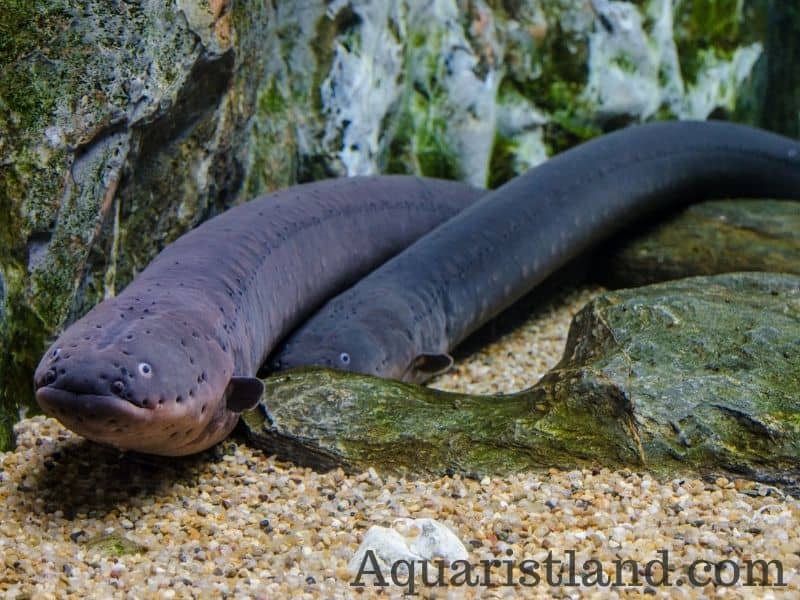
Characteristics:
- It has an elongated, cylindrical body,
- They usually grow about 2 meters with a weight of 44 lb.
- The back is dark gray-brown, orange or yellow belly is typical for this species.
- Mouth is square and has no scales on the body.
- The anal fin of the Electric eel extends the length of the body to the tip of the tail.
- An adult electric eel is capable of generating about 800 volts of electricity.
Electric Eels in Aquarium:
- Aquarist Experience Level: Expert
- Minimum Tank Size: 200 gallons or 757 Liters.
- Temperament: Semi-aggressive
- Aquarium Hardiness: Moderately Difficult
- Temperature: 74.0-82.0° F or 23.3-27.8° C
- In captivity, they can live about 15-20 years.
- These predatory fish are naturally carnivorous and feed on insects, crustaceans, fish, etc.
Similarities with Eels:
The body structure is the primary similarity with a true eel. Moreover, they have anal fins like a true eel and lacks pelvic fins.
Differences with Eels:
Electric isn’t a true eel, rather a knifefish. It doesn’t have dorsal fins like an eel. Also, the mouth shape is different from an eel. A true eel can’t produce electrical discharge like this species.
10. Asian Swamp Eel:
Another eel-like fish that isn’t a true eel. Asian Swamp Eel is a freshwater fish that has been introduced in Georgia and Florida. They’re Originally from the East and Southeast Asia. The other common names are rice eel, rice paddy eel, and rice field eel.
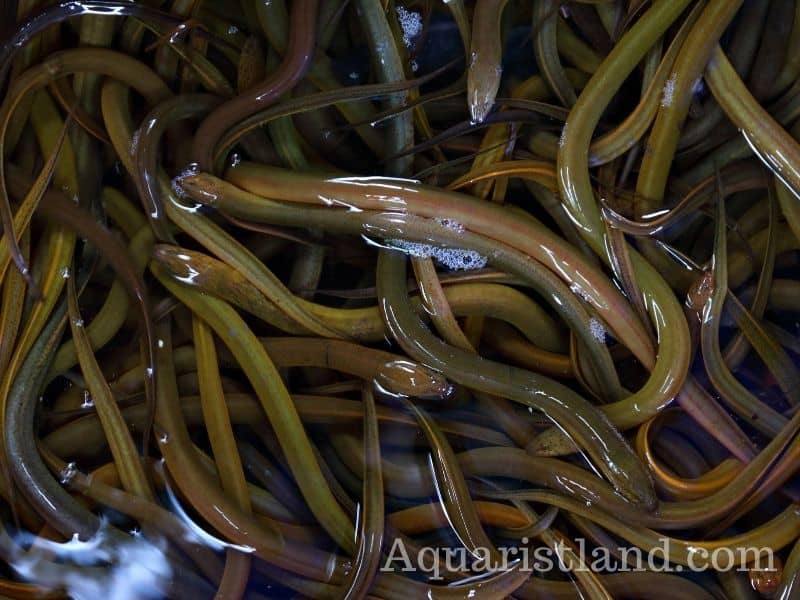
Characteristics:
- The Asian swamp eel has a scaleless, eel-like body
- Typically, they grow about 25-40 cm in length.
- it has a tapering tail and blunt snout
- it has no pectoral or pelvic fins.
- The dorsal, anal, and caudal fins are basic.
- The color varies from olive to brown with few dark flecks.
Asian Swamp Eel in Aquarium:
- Care Level: Expert
- Aggressive in nature. So, better keep alone.
- 75+ gallon tanks for juveniles and 180+ gallons for adults
- PH level: pH: 6.0-8.0
- Hardness: 3-25°H
- Temperature: 77-82°F (25-28°C) is recommended
- In captivity, they can grow about 40-45 inches in length.
Similarities with Eels:
The Asian Swamp eel has a long, slender, and elongated body like a true eel. It has no pectoral or pelvic fins either. Even though they’ve dorsal, anal, and caudal fins like an eel, but those are rudimentary.
Differences with Eels:
The dorsal fins are basic on Asian swamp eel. The usual living place of these two species varies from each other. Also, it has a blunt snout.
11. Fire Eel:
A comparatively large species of spiny eel is the Fire eel. It’s an omnivorous fish that is native to Southeast Asia. The fire eel is a renowned fish in the aquarium trade. Also, this isn’t a true eel either.
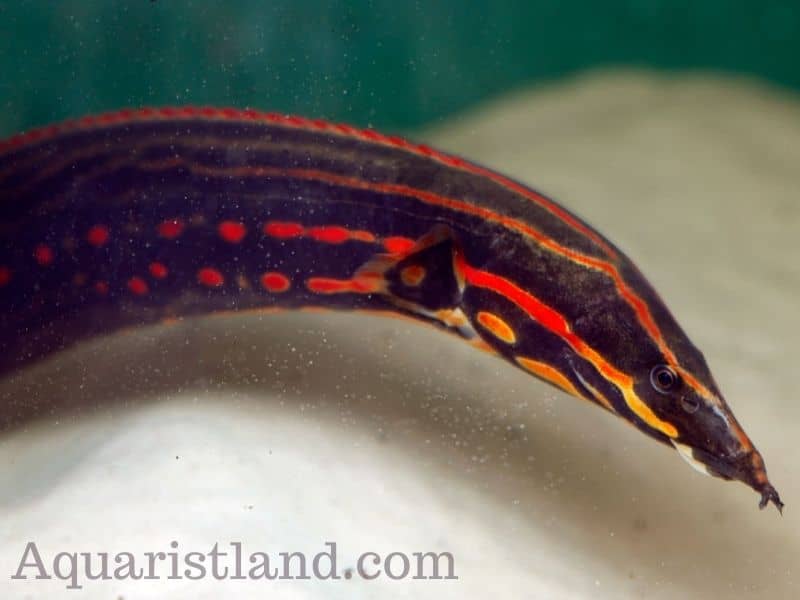
Characteristics:
- It has an extremely elongated body
- Its body flattens as it joins the caudal fin and forms an extended tail.
- The fire eel’s base coloring is dark brown/grey with bright red lateral stripes and spots marks.
- The anal, pectoral, and dorsal fins have a red edging.
- It can reach up to 1 m (3.3 ft) in length.
Fire eel in Aquarium:
- Care Level: Medium
- Tank Size: No less than 52 Gallons or 200 liters.
- It’s an Omnivore Aggressive Predatory fish.
- In captivity, it can grow 1 meter with 10 years of lifespan.
- Water Condition, Temperature: 75-82 °F, pH: 6.8-7.5, Hardness: 6-15.
Similarities with Eel:
The elongated body is similar to an Eel. The anal and dorsal fins have similarities to each other. The caudal fins with an extended tail are also alike to the eel.
Differences with Eel:
The fire eel has pectoral fins that are absent for most eel species. It has lateral stripes and spot marks, which are absent on an eel body.
12. Moray eel:
The Moray eel or Muraenida family of fish has a membership of over 200 species found worldwide in both saltwater and freshwater environments. The most well-known members prefer brackish water; however, seven different types live solely on freshwaters too!

Characteristics:
- Moray eels are known for their muscular bodies that flatten out as they get closer to the tail.
- They’re found in various colors, including green, black, gray, brown, yellow, blue, orange, and white with different stripes, blotches, spots, and patterns.
- The skin is scaleless, smooth, and thick.
- They have long dorsal fins that extend from the head down to each side in a continuous tail.
- They have an elongated snout, large eyes, and mouth that contains many sharp small teeth.
Moray Eel in Aquarium:
- Care Level: Moderate
- Temperament: Semi-aggressive
- Captivity Lifespan: 10-30 years
- They can reach about 4.5-156 inches (Species dependent)
- Minimum Tank Size: 15-30 gallons (Depended on Species)
- Diet: Carnivore
Similarities with Eels:
Moray eel has a long snake-like body like an eel. Their dorsal, caudal, and anal fins are present and have similarities with eels. They also lack pelvic and pectoral fins like an eel.
Differences with Eels:
The skin is thicker than a usual eel. The color variety is identical compare to other eel species. It has sharper teeth compare to others.
13. Dragon eel:
The Dragon eel or leopard moray eel is a common fish found throughout the Indo-Pacific waters. It prefers to live in Coral reef areas and can be seen from Réunion up through Hawaiian island populations! The Leopard Moray Eels diet consists primarily of invertebrates such as shrimp or other small crustaceans, often associated with rocky reefs at depths between 8 – 60 meters deep.
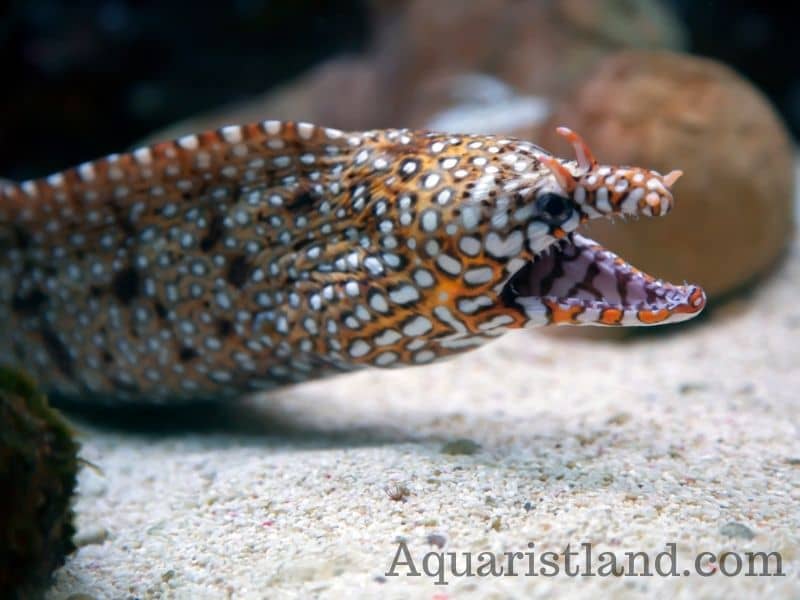
Characteristics:
- These eels have orange, black, yellow, and red patterning that runs the entire length of their body!
- The Dragon Moray has a huge gaping mouth that’s packed with sharp teeth.
- It can grow up to a length of 92 cm.
- The mouth and nostrils are narrow to help them catching any prey,
- Bright red markings on top make them look like anglerfish!
- And, it also has a long slender body like other eel species.
Dragon eel in Aquarium:
- Care Level: Easy
- Diet: Carnivore
- Recommended Tank Size: 180 gallons or more.
- Aggressive in Nature.
- Water Condition, temperature of between 65-78 °F, pH levels: 8.0-8.4, dKH: 8-12.
Similarities with Eel:
The Leopard moray eel or dragon eel is from Moray eel. So, the similarities between them are identical. The long slender body with dorsal fins on its back is like to eel. The sharp teeth are similar to other morays.
Differences with Eel:
Other eel species don’t have this much vibrant color like dragon moray. It also has bright red markings on the top of its head, which is absent in other eel species
Final Say:
There’s a lot of fish that have a similar appearance to an eel. Most of the fish species we’ve mentioned here aren’t true eel. But they do exactly look like an eel. The slender, elongated body with the snake-like movement of these fish species can easily confuse you with one another.
However, if you’re looking for a new pet fish that look like eels, try Bichir/ Polypterus senegalus/ Polypterus palmas, Reedfish, Pangio (kuhli), West African lungfish, Rock gunnel, Eel-tailed catfish, or Electric Eel, Asian Swamp Eel, Fire Eel, Moray eel, Dragon eel.
Mentioned fish species are the most common eel-like fish. However, other fishes have a similar appearance, including Grey Conger, Ocellated Spiny eel, Tire Track eel, Zig-Zag eel, Peacock eel, Rubber eel, Purple Spaghetti eel, Zebra Moray, Lamprey eel, etc.
Is there any fish that you want to recommend on this list? Please, let us know in the comment section below.
Image Sources:
- commons.wikimedia.org
- Canva
- istockphoto.com

